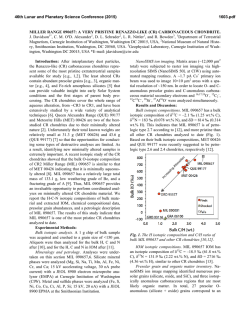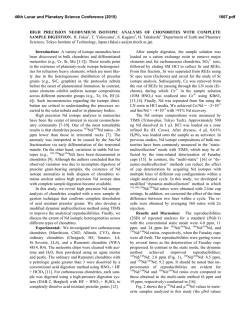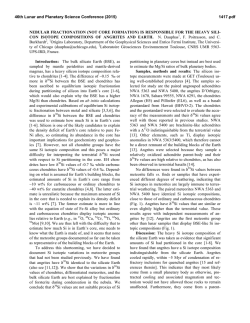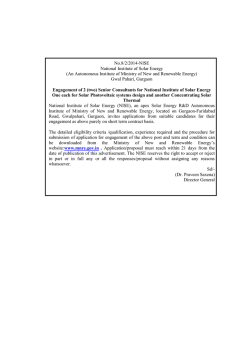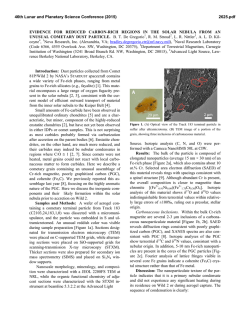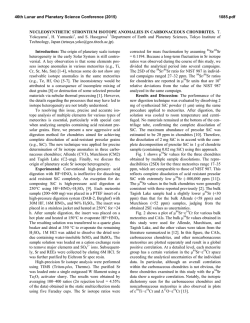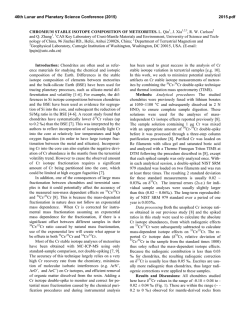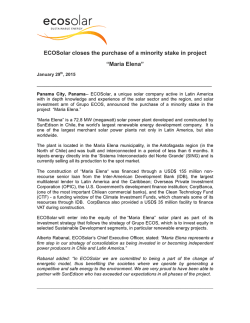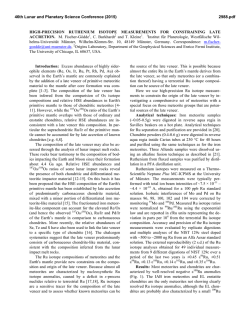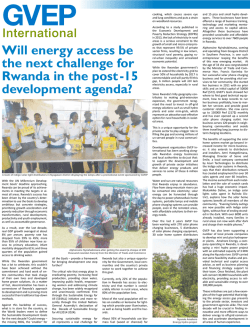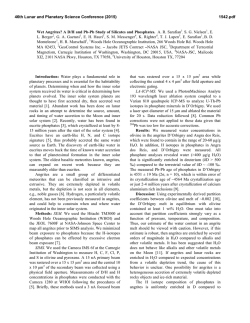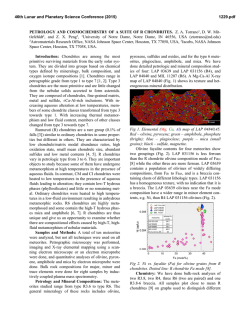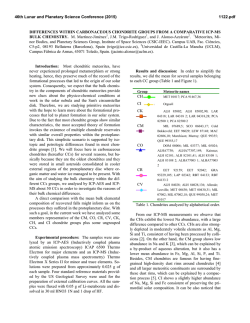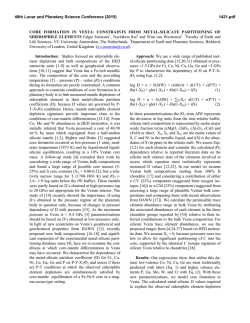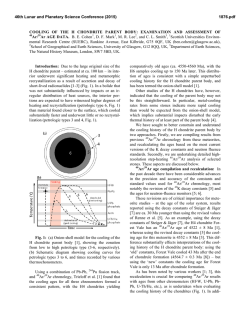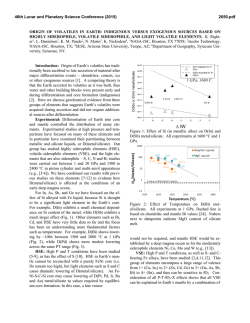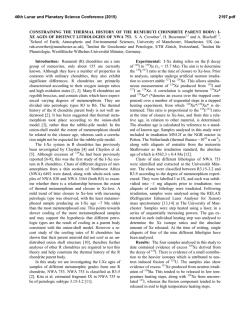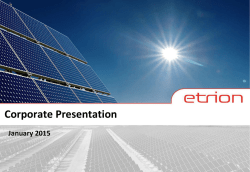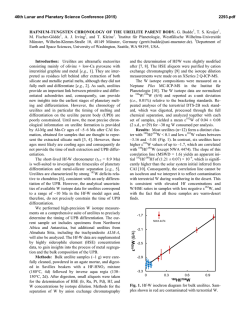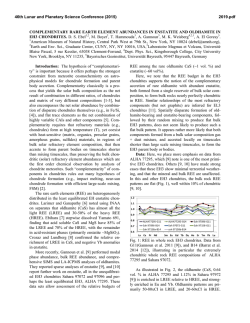
The Problem with the Estimated Re/Os Ratio of the Solar Nebula
46th Lunar and Planetary Science Conference (2015) 2361.pdf THE PROBLEM WITH THE ESTIMATED Re/Os RATIO OF THE SOLAR NEBULA. M. Sharma1, A. Jurewicz1, and D. Burnett2. 1Department of Earth Sciences, 6105 Fairchild Hall, Dartmouth College, Hanover, NH 03755, 2Division of Gelogical & Planetary Sciences, MS 170-25, Caltech, Pasadena CA 91125. Introduction: The 187Re-187Os isotope system ( Re187Os + t1/2 = 41.2 billion years) has been extensively used in models of the evolution of the planetary mantles (e.g., [1-3]). These models assume that (1) the Os isotope composition of solar nebula was homogeneous and (2) the present-day chondritic 187 Os/188Os ratio is reflective of the time-integrated Re/Os ratio of the nebula. Whereas assumption (1) is supported by a number of well-constrained isochrones and by uniform stable Os isotope composition of different meteorites and terrestrial samples, we do not yet have a clear understanding of (2), the Re/Os ratio of the solar nebula. Since the abundances of a number of non-volatile elements match between solar photosphere and carbonaceous chondrites, of which CI appear least fractionated, cosmochemists have so far assumed that the Re/Os ratio of the solar nebula was identical to that of CI. Here we discuss that assumption (2) is not robust: a new, experimental determination using GENESIS samples is needed to validate the time-integrated Re/Os ratio of the solar system. Re/Os ratio of the Solar Nebula: During the last ten years there has been a substantial improvement in our understanding of mixing and homogenization within solar nebula, the result of a number of studies searching for nucleosynthetic anomalies in meteorites and their components. For example, the discovery of deficits in p-process 144Sm and excesses in r-process 135 Ba and 137Ba in bulk samples of C-chondrites with respect to a variety of O-chondrites, an E-chondrite, a eucrite, and Earth [4-6] points to a large scale heterogeneity between the inner solar system and relatively outer regions of the solar nebula where C-chondrites formed. Second, the discovery that the most abundant CAIs found in C-chondrites display larger-magnitude excesses in 135Ba and 137Ba and deficits in 144Sm than those in bulk samples [7] suggests that the incorporation of these objects in accreting C-chondrite parent bodies is the underlying cause of the observed heterogeneity. Finally, the discovery of correlated nucleosynthetic anomalies in different elements (e.g., 54Cr, 26Mg, 62 Ni, 84Sr, 92Mo, 183W), as well as for isotopes of a single element (46Ti, 50Ti) believed to originate from distinct stellar sources [8-12] in bulk-samples of chondrites and/or their leachates and residues, has required modification of the standard model which assumed that C-chondrites were the dominant building blocks for the terrestrial planets (Fig.1; [13]). 187 Fig. 1. C- chondrites and O- chondrites (EH, H, L and LL) cluster in two groups in ε54Cr-ε50Ti space (modified from [13]). Their Re/Os ratios also display a bimodality (inset- Re/Os data from [14]). In comparison, the similarity of high-precision stable-isotope ratios for Os for Earth and different classes of meteorites indicates a rather homogeneous protosolar nebula for Os isotopes [15-17]. Synthesis of a large body of Re-Os data has shown, however, that the present-day 187Os/188Os ratio of the terrestrial primitive upper mantle, Moon, Mars and Howardite-EucriteDiogenite parent body (asteroid 4 Vesta) are identical to that of O- chondrites/E- chondrites (= 0.129) and higher than C- chondrites (= 0.126) (c.f., [18] and references therein). This observation indicates that the time-integrated Re/Os ratios of the Earth, Moon, Mars and 4 Vesta are similar to that of O- chondrites/Echondrites but not C-chondrites (Fig. 1). As the Earth, Moon, Mars and 4 Vesta have extremely different evolutionary histories, the above observation is remarkable! As Re and Os are amongst the most refractory elements [14, 19] the observed bimodality in Re/Os ratio cannot easily be explained as a consequence of volatility-based fractionations within the nebula. Variations in refractory element ratios in bulk chondrites could be related to the incorporation of CAI components with fractionated refractory element abundances [20]. This postulate is not supported by CAI data [21], suggesting CAIs could only play a subservient role in controlling the Re/Os ratio of chondrites. Further, it is intriguing that the set of meteorite groups which differ in their Re/Os ratios is the same set distinguished by distinct nucleosynthetic anomalies 46th Lunar and Planetary Science Conference (2015) (Fig. 1). Since mixing and thermal processing of presolar grains under nebular conditions likely did not impact the Re/Os ratio of the nebula, differential mobilization of Re over Os in the parent bodies of chondrites was likely responsible for the observed variation. For example, parent bodies of C-chondrites and especially CI chondrites underwent extensive aqueous alteration that involved dissolution/hydration of primary minerals (serpentinization of olivine and pyroxenes), precipitation of secondary minerals (magnetite, sulfate, carbonates) (e.g., [22-24]) and formation/redistribution of organic matter [25]. Although water-rock interaction is considered static and isochemical, a recent study [26] suggests convective transport could also be possible in a large parent body being heated by decay of 26Al. If so, it is possible that the Re/Os in CI chondrites was modified from low temperature water-rock interaction. These observations suggest that the Re/Os ratio of CI chondrites cannot be assumed to be identical that of the solar nebula. Re/Os ratio of the Solar Photosphere: Since solar photosphere has been isolated from the nuclear reactions taking place in the solar core, its Re/Os ratio should be the same as that of the solar nebula. The solar Re/Os ratio is not known. While direct measurements of solar Os abundance have been made [27-29], there is only one early attempt to provide an upper limit of Re abundance of 0.015 atoms/106 Si atoms (or 0.01042 g/g) [30]. This limit appears to be consistent with the ”smooth odd mass curve” criterion [31, 32] and taken at its face value and using the most recent Os abundance determination, we find that the solar Re/Os ratio is <0.0200. In comparison, the Re/Os ratio of CI chondrite Orgueil is 0.0797—at least a factor of four higher than the upper limit obtained by analysis of solar spectrum! A direct estimation of the solar Re/Os is therefore needed to provide a benchmark against which early alteration processes on meteorite parent bodies and planetary evolution scenarios could be evaluated. Genesis-returned solar wind (SW) provides a unique opportunity for determining the time integrated Re/Os ratio. No fractionation of Os or it’s isotopes during SW formation is predicted: first, the first ionization potential (FIP) of Os is 8.7 eV, which is less than the observed FIP threshold of ~10 eV beyond which elements are depleted in the corona relative to the photosphere by a factor of ~2 (e.g.,[33]); second, calculations for inefficient coulomb drag in these uniformly-heavy isotopes indicate no measurable massdependent fractionation (cf. ([34]). So, the Genesis SW Os concentration and isotope composition deter- 2361.pdf mination, which would also yield a SW Re abundance, will be a direct proxy for the photosphere. The 2-year Genesis array Os fluence is 1.3 × 106 Os atoms/cm2 (2.2cm2/fg). At Dartmouth we have developed extremely sensitive measurement techniques for Os isotopes in water and routinely measure 100200 fg Os (e.g., [35]). In our recent work on polar ice, we have successfully measured Os isotopes in samples containing a total of 30-50 fg of Os. The area of one Genesis array wafer is 50 cm2. This would yield ~20 fg of Os. The experiment therefore requires an area equivalent to ~1 array wafer to make a measurement— a technically challenging issue is therefore to find a) low background GENESIS material and b) develop ultraclean procedures to remove surface contaminants and obtain the Os fluence and 187Os/188Os ratio of SW. We will present of initial assessment of materials and background contaminants. References: [1] Day J. et al. (2010), EPSL, 289, 595605.[2] Shirey S.B. and Walker R.J. (1998), Ann.Rev Geol. Planet. Sci., 26, 423-500.[3] Brandon A.D. et al. (2000), GCA, 64, 4083-4095.[4] Andreasen R. and Sharma M. (2006), Science, 314, 806-809.[5] Andreasen R. and Sharma M. (2007), ApJ, 665, 874-883.[6] Carlson R.W. et al. (2007), Science, 316, 1175-1178.[7] Brennecka G.A. et al. (2013), PNAS, 110, 17241-17246. [8] Burkhardt C. et al. (2012), EPSL, 357, 298-307.[9] Larsen K.K. et al. (2011), ApJ Lett., 735.[10] Paton C. et al. (2013), ApJ Lett., 763.[11] Regelous M. et al. (2008), EPSL, 272, 330-338.[12] Trinquier A. et al. (2009), Science, 324, 374-376.[13] Warren P.H. (2011), EPSL, 311, 93-100.[14] Walker R.J. (2002), GCA, 66, A818A818.[15] Yokoyama T. et al. (2007), EPSL, 259, 567580.[16] Walker R.J. (2012), EPSL, 351–352, 36–44.[17] Brandon A.D. et al. (2005), GCA, 69, 1619-1631.[18] Walker R.J. (2009), Chemie Der Erde, 69, 101-125.[19] Horan M.F. et al. (2003), Chem Geol, 196, 5-20.[20] Stracke A. et al. (2012), GCA, 85, 114-141.[21] Archer G.J. et al. (2014), GCA, 131, 402-414.[22] Riciputi L.R. et al. (1994), GCA, 58, 1343-1351.[23] Velbel M.A. et al. (2012), GCA, 87, 117-135.[24] Zolensky M.E. et al. (2008), Rev Mineral, 68, 429-462.[25] Le Guillou C. et al. (2014), GCA, 131, 368392.[26] Palguta J. et al. (2010), EPSL, 296, 235-243.[27] Asplund M. et al. (2009), Annu Rev Astron Astr, 47, 481522.[28] Kwiatkowski M. et al. (1984), Astron Astrophys., 135, 59-60. [29] Quinet P. et al. (2006), Astron Astrophys, 448, 1207-U93.[30] Swensson J.W. (1970), Sol Phys, 13, 25&.[31] Anders E. and Grevesse N. (1989), GCA, 53, 197214.[32] Burnett D.S. et al. (1989), GCA, 53, 471-481.[33] Schmelz J.T. et al. (2012), ApJ, 755.[34] Bochsler P. (2007), Astron Astrophys Rev., 14, 1-40. [35] Chen C. and Sharma M. (2009), Anal Chem, 81, 5400-5406.
© Copyright 2026
